
The Missouri Botanical Garden is a botanical garden located at 4344 Shaw Boulevard in St. Louis, Missouri. It is also known informally as Shaw's Garden for founder and philanthropist Henry Shaw. Its herbarium, with more than 6.6 million specimens, is the second largest in North America, behind that of the New York Botanical Garden. The Index Herbariorum code assigned to the herbarium is MO and it is used when citing housed specimens.
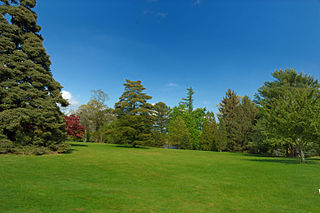
Bayard Cutting Arboretum State Park is a 691-acre (2.80 km2) state park located in the hamlet of Great River, New York, on Long Island. The park includes an arboretum designed by Frederick Law Olmsted for William Bayard Cutting in 1886, as well as a mansion designed by Charles C. Haight. Today Bayard Cutting Arboretum State Park is one of the last remaining estates on the South Shore of Long Island. It has been listed on the National Register of Historic Places since 1973 as a historic district. Robert Fulton Cutting, known as the “first citizen of New York” and his wife Helen Suydam Cutting, niece to Caroline Astor, would frequent the manor house and estate as both William and Robert were brothers. Together Robert and William brought the sugar beet industry to the United States.

The Montreal Botanical Garden is a large botanical garden in Montreal, Quebec, Canada comprising 75 hectares of thematic gardens and greenhouses. It was designated a National Historic Site of Canada in 2008 as it is considered to be one of the most important botanical gardens in the world due to the extent of its collections and facilities.

Hakone Gardens is an 18-acre (7.3 ha) traditional Japanese garden in Saratoga, California, United States. A recipient of the Save America's Treasures Award by the National Trust for Historic Preservation, it is recognized as one of the oldest Japanese-style residential gardens in the Western Hemisphere. Notable features include a bamboo garden, a Zen garden, a strolling garden, tea houses, and the Cultural Exchange Center, which is an authentic reproduction of a 19th-century Kyoto tea merchant's house and shop.

Sonnenberg Gardens and Mansion State Historic Park is a 50-acre (20 ha) state park located at 151 Charlotte Street in Canandaigua, New York, at the north end of Canandaigua Lake, in the Finger Lakes region of Upstate New York. The house and gardens are open to the public every day, May through October.

Wave Hill is a 28-acre (11 ha) estate in the Hudson Hill section of Riverdale in the Bronx, New York City. Wave Hill currently consists of public horticultural gardens and a cultural center, all situated on the slopes overlooking the Hudson River, with expansive views across the river to the New Jersey Palisades. The estate includes two houses and a botanical garden. The oldest part of the main house, Wave Hill House, dates to 1843; Glyndor House dates from 1927 and contains a multi-room art gallery. Perkins Visitor Center, which was originally a garage, contains a gift shop and an information desk.

James Henry Dooley was a Virginia lawyer, business leader, politician, and philanthropist based in Richmond during Reconstruction and the Gilded Age. He represented Richmond in the Virginia House of Delegates for three terms.

Swannanoa is an Italian Renaissance Revival villa built in 1912 by millionaire and philanthropist James H. Dooley (1841–1922) above Rockfish Gap on the border of northern Nelson County and Augusta County, Virginia, in the US. It is partially based on buildings in the Villa Medici, Rome.
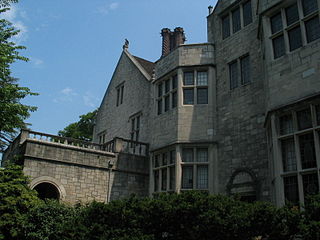
Planting Fields Arboretum State Historic Park, which includes the Coe Hall Historic House Museum, is an arboretum and state park covering over 400 acres (160 ha) located in the village of Upper Brookville in the town of Oyster Bay, New York.
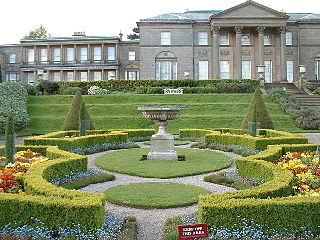
Tatton Park is a historic estate in Cheshire, England, north of the town of Knutsford. It contains a mansion, Tatton Hall; a medieval manor house, Tatton Old Hall; Tatton Park Gardens, a farm and a deer park of 2,000 acres (8.1 km2). It is a popular visitor attraction and hosts over a hundred events annually. The estate is owned by the National Trust and is managed under lease by Cheshire East Council. Since 1999, it has hosted North West England's annual Royal Horticultural Society flower show.
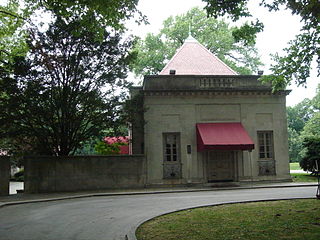
The Curtis Arboretum is a 45-acre (18 ha) arboretum in Wyncote, Pennsylvania. The arboretum was founded by Mary Louise Curtis Bok in honor of her father, Cyrus Curtis.

The Dallas Arboretum and Botanical Garden is a 66-acre (27 ha) botanical garden located at 8525 Garland Road in East Dallas, Texas, on the southeastern shore of White Rock Lake.

The Morris Arboretum & Gardens of the University of Pennsylvania is the official arboretum of the Commonwealth of Pennsylvania. The Arboretum is open daily except for major holidays. It is located at 100 East Northwestern Avenue, Chestnut Hill, Philadelphia, Pennsylvania.

The Norfolk Botanical Garden is a botanical garden with arboretum located at 6700 Azalea Garden Road, Norfolk, Virginia.

Forest Hill Park, known for its "Stone house" called Boscobel, is a historic 105-acre (0.4 km2) urban park in Richmond, Virginia. Starting as a private property, the park has had several owners and uses before its present one, the City of Richmond.
Charles Freeman Gillette (1886–1969) was a prominent landscape architect in the upper South who specialized in the creation of grounds supporting Colonial Revival architecture, particularly in Richmond, Virginia. He is associated with the restoration and re-creation of historic gardens in the upper South and especially Virginia. He is known for having established a regional style—known as the "Virginia Garden."

Congregation Beth Ahabah is a Reform Jewish synagogue at 1121 West Franklin Street, Richmond, Virginia, in the United States. Founded in 1789 by Spanish and Portuguese Jews as Kahal Kadosh Beth Shalome, it is one of the oldest synagogues in the United States.
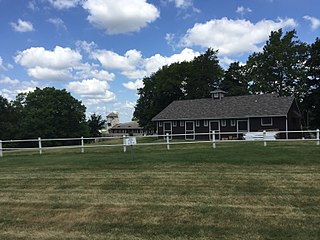
Cragwold, also known as Edwin A. Lemp Estate, in St. Louis County, Missouri was built in 1911.

Shofuso (Pine Breeze Villa), (Japanese: 松風荘) also known as Japanese House and Garden, is a traditional 17th century-style Japanese house and garden located in Philadelphia's West Fairmount Park on the site of the Centennial Exposition of 1876. Shofuso is a nonprofit historic site with over 30,000 visitors each year and is open to the public for visitation and group tours.

Gardens of the World is a botanical garden in Thousand Oaks, California, situated directly across Thousand Oaks Boulevard from Thousand Oaks Civic Arts Plaza, within the downtown core of the city. Established in 2001, the park was given to the city by the owners of a local travel agency. It is home to a French garden and waterfall, an English rose garden, an Italian grapevine garden and a Japanese garden with koi ponds and a pagoda. The park is used for walking and picnicking, and guided tours of the gardens are available. The Californian Mission Courtyard includes native California flora and murals of the remaining 21 California Missions. There is also a statue of Father Junipero Serra in this part of the park. The botanical garden is 4.5 acres (1.8 ha).




























